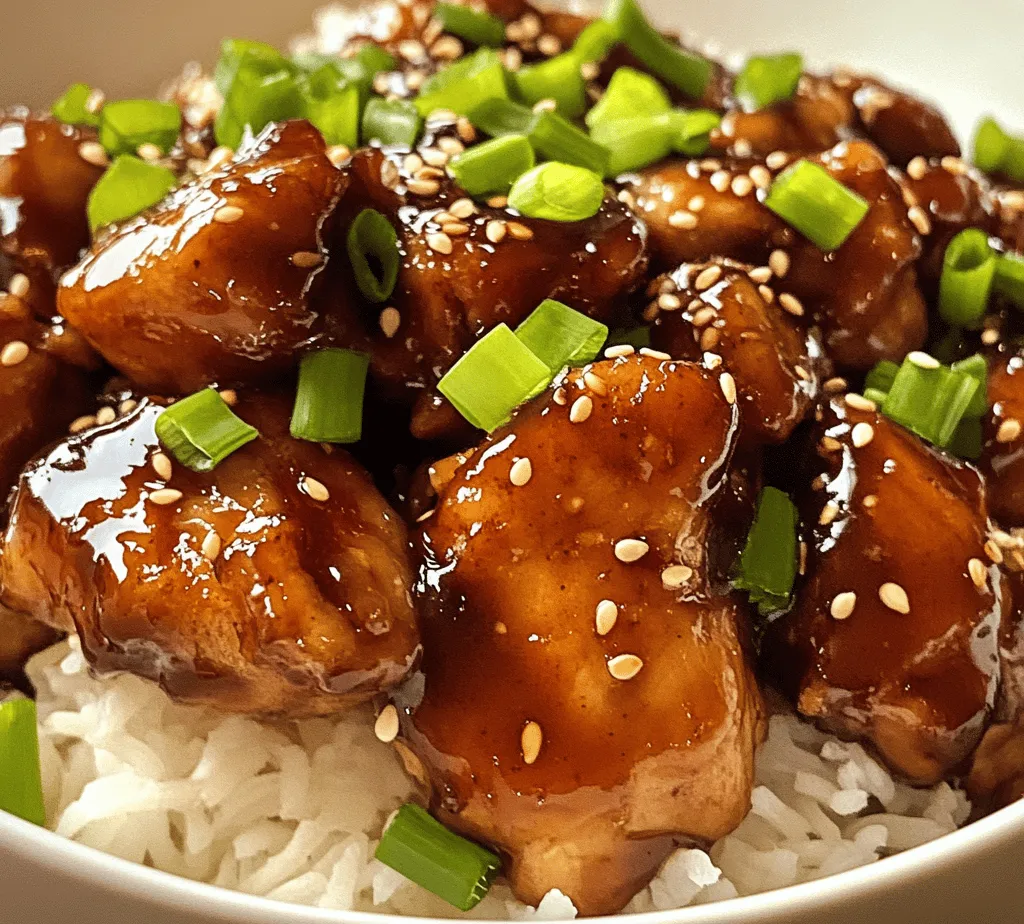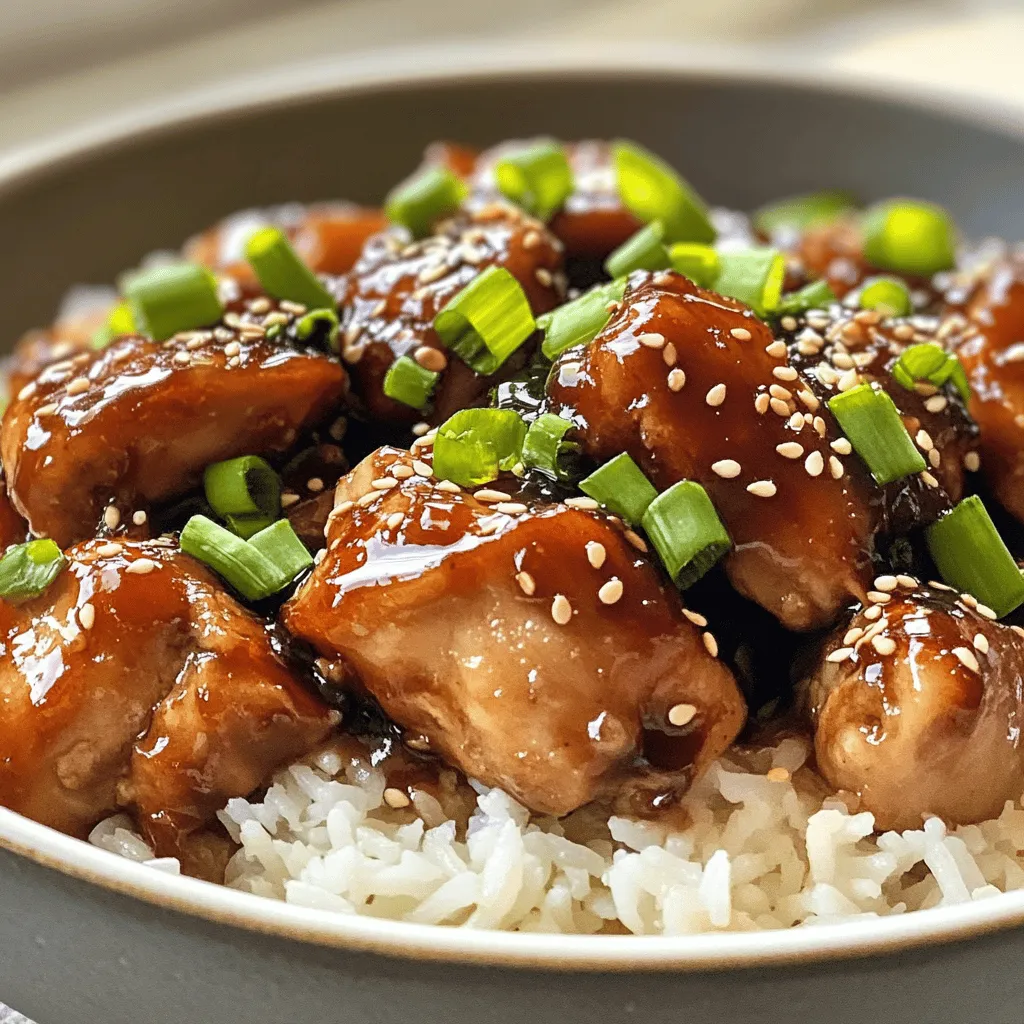Introduction
Mongolian cuisine is a treasure trove of flavors and hearty dishes, reflecting the rich cultural heritage of Mongolia, a land known for its nomadic lifestyle and pastoral traditions. This cuisine has gained immense popularity around the world, especially for its signature dishes that embrace bold flavors and simple ingredients. Among these dishes, Mongolian Chicken stands out as a delightful representation of the fusion of sweet and savory profiles that are characteristic of this culinary tradition.
The allure of Mongolian Chicken lies in its unique balance of flavors. This dish typically combines tender pieces of chicken with a luscious sauce that features sweet notes from honey and a savory depth from soy sauce and hoisin sauce. Together, these ingredients create a mouthwatering dish that is not only satisfying but also incredibly easy to prepare. In today’s fast-paced world, quick and easy recipes have become essential for many home cooks, allowing them to enjoy delicious meals without spending hours in the kitchen.
This 20-Minute Sweet Savory Mongolian Chicken recipe is designed with simplicity and flavor in mind. With just a few staple ingredients and minimal prep time, you can whip up a dish that is sure to impress your family and friends. Whether you’re a busy professional, a parent juggling multiple responsibilities, or simply someone who appreciates a good meal without the fuss, this recipe is for you. Let’s dive into the heart of Mongolian Chicken and explore the fascinating elements that make this dish a favorite.
Understanding Mongolian Chicken
At its core, Mongolian Chicken is a stir-fried dish that features chicken as the primary protein. Though it has roots in Mongolian cuisine, it has evolved over the years, particularly in Western adaptations that have embraced the dish’s essence while incorporating various cooking techniques and flavors. The name “Mongolian” can be somewhat misleading, as the dish does not have historical ties to Mongolia itself but rather reflects a blend of flavors that resonate with Mongolian cooking traditions.
The flavor profile of Mongolian Chicken is a delightful interplay of sweet, savory, and umami tastes. The sweetness typically comes from honey or sugar, while the savory notes are derived from soy sauce and hoisin sauce. This combination creates a rich, sticky sauce that clings to the chicken and vegetables, enhancing each bite. The umami flavor, often described as the “fifth taste,” adds depth to the dish, making it incredibly satisfying.
Chicken holds cultural significance in Mongolian cooking, often serving as a staple protein in various meals. In a country where livestock farming is prevalent, chicken is easily accessible and versatile, allowing for a range of preparations. From simple stir-fries to hearty stews, chicken has earned its place at the dining table, symbolizing nourishment and comfort.
In this recipe, we pay homage to these culinary traditions by bringing you a modern, quick version of Mongolian Chicken that captures the essence of its delightful flavors while fitting seamlessly into your busy lifestyle.
Ingredients Breakdown
To create this 20-Minute Sweet Savory Mongolian Chicken, you’ll need a selection of ingredients that work harmoniously to deliver the dish’s signature taste. Here’s a closer look at each ingredient and its role in this flavorful recipe:
Chicken Thighs
Using boneless, skinless chicken thighs is a game changer for this dish. Chicken thighs are known for their rich flavor and tender texture, making them ideal for stir-frying. Unlike chicken breasts, which can dry out quickly, thighs remain juicy and absorb flavors well, ensuring that every bite is succulent. Their higher fat content also contributes to the overall richness of the dish, enhancing the sweet and savory sauce.
Soy Sauce and Hoisin Sauce
These two sauces are crucial to achieving the authentic Mongolian flavor profile. Soy sauce brings a deep savory note and a hint of saltiness, while hoisin sauce adds a layer of sweetness and complexity with its unique blend of spices and ingredients. Together, they create a robust sauce that forms the base of the dish, coating the chicken and any accompanying vegetables.
Honey and Rice Vinegar
To balance the flavors, honey is added for sweetness, complementing the savory elements of the soy and hoisin sauces. The use of honey not only enhances the dish’s flavor but also contributes to the sauce’s sticky texture. Rice vinegar, on the other hand, introduces a tangy note that cuts through the richness, providing a well-rounded taste experience. This balance between sweet and tangy is essential for creating a dish that is both satisfying and refreshing.
Garlic and Ginger
Garlic and ginger are staples in many Asian cuisines and are used in this recipe to add depth and aromatic qualities. Freshly minced garlic infuses the dish with a savory aroma, while ginger provides a touch of warmth and spice. Together, they elevate the overall flavor profile, ensuring that the dish is not only sweet and savory but also aromatic and inviting.
Cornstarch
Cornstarch serves as a thickening agent, helping to create a luscious sauce that clings to the chicken and vegetables. When mixed with the marinade, it not only ensures that the sauce has the perfect consistency but also helps to achieve a beautiful glaze when stir-fried. This is especially important in quick cooking methods, where achieving the right texture can make a significant difference in the dish’s final presentation.
Vegetable Oil
Choosing the right cooking oil is crucial for stir-frying. A high smoke point oil, such as vegetable oil, is ideal as it can withstand the high temperatures needed for quick cooking. This ensures that the chicken sears properly without sticking to the pan, resulting in a deliciously caramelized exterior.
Green Onions and Sesame Seeds
These ingredients serve as finishing touches that enhance both the flavor and presentation of the dish. Chopped green onions provide a fresh, crisp element that brightens the overall taste, while sesame seeds add a subtle nuttiness and a pleasing crunch. These garnishes not only elevate the visual appeal but also add texture, making each bite more enjoyable.
Cooked Rice
Serving Mongolian Chicken over a bed of cooked rice is a classic way to enjoy this dish. The rice acts as a neutral base that absorbs the flavorful sauce, balancing the richness of the chicken. Brown rice, jasmine rice, or even cauliflower rice can be used depending on your dietary preferences, making this dish versatile and adaptable.
Step-by-Step Cooking Instructions
Now that we have a solid understanding of the ingredients involved, it’s time to dive into the cooking process. This recipe is designed to be quick and straightforward, perfect for a busy weeknight dinner. Here’s a detailed guide on how to prepare your Sweet Savory Mongolian Chicken.
Marinate the Chicken
The first step in creating flavorful Mongolian Chicken is to marinate the chicken thighs. Begin by cutting the boneless, skinless chicken thighs into bite-sized pieces. This not only ensures even cooking but also allows the marinade to penetrate the meat better.
In a mixing bowl, combine the following ingredients for the marinade:
– ¼ cup soy sauce
– 2 tablespoons hoisin sauce
– 2 tablespoons honey
– 1 tablespoon rice vinegar
– 1 clove minced garlic
– 1 teaspoon minced ginger
– 1 tablespoon cornstarch
Whisk the ingredients together until well combined. Add the chicken pieces to the marinade, ensuring they are evenly coated. Cover the bowl with plastic wrap and let it marinate for at least 15 minutes. This step is crucial as it allows the flavors to infuse into the chicken, resulting in a more delicious final dish.
Prepare for Stir-Frying
While the chicken is marinating, take this time to prepare your cooking station. Gather all your ingredients and have them ready to go, as stir-frying is a quick process that requires your full attention.
Heat a large skillet or wok over medium-high heat. Once the pan is hot, add 2 tablespoons of vegetable oil. It’s important to allow the oil to heat properly before adding the chicken. This will help prevent sticking and ensure that the chicken sears beautifully.
Cooking the Chicken
After the oil has heated, add the marinated chicken to the skillet in an even layer. Avoid overcrowding the pan, as this can lower the temperature and result in steaming rather than searing. If necessary, cook the chicken in batches to achieve the best results.
Cook the chicken for about 5-7 minutes, stirring occasionally, until it is cooked through and has a nice golden brown color. The cornstarch in the marinade will create a delicious glaze as the chicken cooks.
Adding the Finishing Touches
Once the chicken is cooked, you can add a handful of chopped green onions for extra flavor. Toss them in for the last minute of cooking to soften them slightly while retaining their vibrant color. Make sure to scrape up any flavorful bits that may have stuck to the bottom of the pan, as these will add depth to your sauce.
After the chicken is done, you can serve it hot over a bed of cooked rice, garnishing with sesame seeds and additional green onions as desired.
This Sweet Savory Mongolian Chicken recipe is not just a quick meal; it’s an experience that brings the essence of Mongolian flavors to your table in record time.
Stay tuned for the next part of this article, where we’ll delve into expert tips for achieving the best results with this dish and answer some common questions about Mongolian Chicken!

Techniques for Achieving Perfect Browning on the Chicken
Achieving that coveted golden-brown crust on your Mongolian Chicken is key to enhancing both flavor and presentation. Here are some essential techniques to help you achieve perfect browning:
1. Pat Dry the Chicken: Before seasoning and cooking, use paper towels to pat the chicken pieces dry. Removing excess moisture ensures that the chicken sears properly rather than steams.
2. Use High Heat: Begin cooking the chicken over medium-high heat. This temperature helps create a nice sear while keeping the inside juicy.
3. Avoid Overcrowding the Pan: When adding chicken to the skillet, make sure not to overcrowd the pieces. If too many pieces are in the pan at once, they will steam rather than brown. Cook in batches if necessary.
4. Let the Chicken Cook Undisturbed: Once you place the chicken in the pan, resist the urge to move it around too much. Allow it to cook undisturbed for several minutes until it naturally releases from the pan and develops a beautiful crust.
5. Use the Right Oil: Choose an oil with a high smoke point, such as vegetable oil, canola oil, or peanut oil. These oils can withstand higher temperatures without burning, leading to better browning.
How to Properly Add and Thicken the Sauce
Adding and thickening the sauce properly is crucial to achieving that sweet and savory flavor profile that makes Mongolian Chicken so delicious. Follow these steps:
1. Prepare the Sauce Separately: In a bowl, whisk together soy sauce, brown sugar, garlic, and ginger. Having the sauce ready before you begin cooking helps streamline the process.
2. Deglaze the Pan: Once the chicken is cooked and removed from the skillet, pour the prepared sauce into the hot pan. This will deglaze the pan, lifting any flavorful bits that stuck to the bottom during cooking.
3. Simmer to Develop Flavor: Allow the sauce to simmer for a few minutes over medium heat. This will help the flavors meld together while slightly reducing the sauce.
4. Thicken the Sauce: To achieve that perfect, glossy consistency, mix a tablespoon of cornstarch with two tablespoons of cold water to create a slurry. Gradually add the slurry to the simmering sauce, stirring constantly. Continue to simmer until the sauce thickens to your desired consistency.
5. Return the Chicken to the Sauce: Finally, add the cooked chicken back to the pan, tossing it in the sauce to ensure every piece is coated with that rich flavor.
Presentation Ideas: Garnishing and Serving Suggestions
Presentation can elevate your Mongolian Chicken from a simple meal to an impressive dish worthy of any occasion. Here are some ideas to make your plating pop:
1. Garnish with Green Onions: Slice fresh green onions and sprinkle them generously over the finished dish. This adds a vibrant color contrast and a fresh crunch.
2. Sesame Seeds: Toasted sesame seeds offer a nutty flavor and a pleasing texture. Sprinkle a few on top of the chicken right before serving.
3. Serve in Bowls: Instead of traditional plates, use deep bowls to serve the Mongolian Chicken over a bed of rice or noodles. This adds a modern touch and makes it easier to enjoy.
4. Add Fresh Herbs: Fresh cilantro or basil can bring a burst of freshness. Roughly chop the herbs and scatter them over the dish for added color and flavor.
5. Accompaniment: Serve with lime wedges on the side, allowing diners to squeeze fresh juice over the dish for an extra zing.
Nutritional Information
Understanding the nutritional profile of your dish is essential for making informed choices. Here’s a breakdown of the nutritional content per serving of Mongolian Chicken:
– Calories: Approximately 350-400
– Protein: 30g
– Fat: 10g
– Carbohydrates: 40g
– Fiber: 2g
– Sugar: 12g
Health Benefits of the Ingredients Used
– Chicken: A great source of lean protein, chicken is essential for muscle growth and repair.
– Soy Sauce: While traditionally higher in sodium, using low-sodium versions can help keep blood pressure in check.
– Ginger and Garlic: Known for their anti-inflammatory properties, both ginger and garlic can boost the immune system and improve digestion.
Suggestions for Making the Recipe Healthier
– Low-Sodium Soy Sauce: Opt for low-sodium soy sauce to reduce the overall salt content in the dish.
– Add Vegetables: Incorporate bell peppers, broccoli, or snap peas into the stir-fry for added fiber, vitamins, and minerals.
– Serve with Brown Rice: Substitute white rice with brown rice or quinoa for a whole grain option that provides more nutrients.
Variations and Customizations
Mongolian Chicken is a versatile dish that can easily be tailored to suit various dietary preferences. Here are some creative variations:
1. Vegetarian and Vegan Alternatives: For a plant-based version, substitute chicken with tofu or seitan. Marinate the tofu in the same sauce for a rich flavor and pan-fry until crispy.
2. Gluten-Free Adaptations: Use tamari or coconut aminos as a gluten-free alternative to soy sauce. Both options maintain the savory flavor without the gluten.
3. Adding Vegetables: Enhance the dish by adding stir-fried vegetables like bok choy, carrots, and zucchini. These additions not only increase the nutritional value but also add color and texture.
4. Spicy Variations: If you enjoy heat, add a teaspoon of chili paste or a dash of sriracha to the sauce. This will give your Mongolian Chicken a spicy kick without overpowering the sweet and savory notes.
Meal Prep and Storage Tips
For those busy weekdays, meal prepping can make life easier. Here are some tips for storing and reheating your Mongolian Chicken:
1. How to Store Leftovers Properly: Allow the chicken to cool completely before transferring it to an airtight container. This will keep the chicken fresh in the refrigerator for up to 3-4 days.
2. Tips for Reheating Without Losing Texture: Reheat the chicken gently in a skillet over low heat. Adding a splash of water or broth can help maintain moisture and prevent the chicken from drying out.
3. Meal Prep Ideas Using Mongolian Chicken: Prepare a batch of Mongolian Chicken and serve it over rice, wrapped in lettuce for a fresh lunch option, or mixed into a salad for a hearty meal.
Serving Suggestions
Think beyond rice when it comes to serving Mongolian Chicken. Here are some creative ideas:
1. Creative Serving Ideas: Instead of plain white rice, consider serving it over fried rice, quinoa, or even cauliflower rice for a low-carb option.
2. Pairing with Side Dishes or Salads: Serve your Mongolian Chicken with a side of steamed vegetables, Asian slaw, or a simple cucumber salad to balance the dish.
3. Wine and Beverage Pairings: Pair your meal with a light white wine like Sauvignon Blanc or a refreshing iced tea. Both options complement the sweet and savory flavors beautifully.
Conclusion
Mongolian Chicken is a delightful dish that boasts easy preparation, rich flavors, and a multitude of serving options that make it suitable for any occasion. Its versatility allows for various adaptations, whether you’re catering to dietary restrictions or simply experimenting in the kitchen.
This recipe invites you to enjoy a taste of Mongolian cuisine at home, providing not just a meal but an experience that brings bold flavors and comfort. So gather your ingredients, follow the steps, and savor the delightful taste of homemade Mongolian Chicken. You won’t be disappointed!



